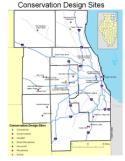Conservation Design Strategy Paper
Conservation Design Strategy Report Summary
 As the projected 2.8 million people join our region in the upcoming decades, we need to consider where they will live, work, shop and play while continuing to provide for our existing population needs. The way we develop and grow has significant impacts on our land, natural resources and infrastructure systems. In order to minimize the negative effects on these commodities, conservation design offers a highly adaptable alternative development approach while still providing all the essential functions and benefits of conventional development.
As the projected 2.8 million people join our region in the upcoming decades, we need to consider where they will live, work, shop and play while continuing to provide for our existing population needs. The way we develop and grow has significant impacts on our land, natural resources and infrastructure systems. In order to minimize the negative effects on these commodities, conservation design offers a highly adaptable alternative development approach while still providing all the essential functions and benefits of conventional development.
Conservation design is a density neutral design strategy that allows for development while working closely with the site's natural functions to maintain and preserve the environmental integrity of the site. Natural landscaping, on site stormwater management and porous pavement are just a few practices that can be incorporated into this design strategy. The purpose of this paper is to explore the principles and potential impacts of conservation design on our region.
A sample of findings:
Primary Environmental Impacts
- Site design that "clusters" lots together, leaving larger continuous open space, allows for natural drainage and cleansing of stormwater before it is introduced to conventional infrastructure.
- Native plants have deeper root systems, which stabilizes the soil, prevents erosion, increases soil permeability, and reduces runoff. Also, the reduced need for lawn equipment prevents smog-forming volatile organic compounds from being released into the air (IL Green Government Coordinating Council).
Primary Cost Savings
- Utilizing native landscaping (instead of traditional turf grass) can provide a cost savings of between $3,950 and $4,583 per acre per year over ten years (Conservation Research Institute, 2005)--some estimate a savings of up to 90% when considering installation and maintenance (IL Green Government Coordinating Council).
- A series of case studies in the US, a complete conservation design approach (ie. native landscaping with clustered lots and sustainable stormwater management) saved an average of 36% over conventional practices (Conservation Research Institute, 2005).
Links
Related Links Maps |
